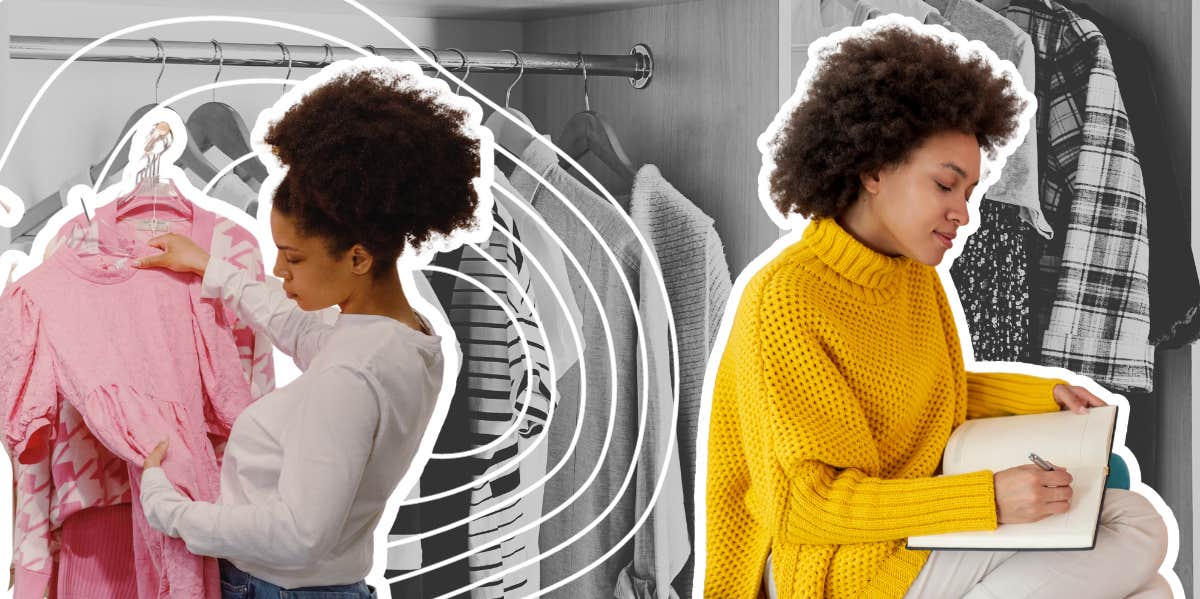How An Unusual Creative Project Cured My Clothing Addiction
Creation is the antidote to consumption.
 Ron Lach | Pexels / vladans | Getty Images / pixelshot | Canva
Ron Lach | Pexels / vladans | Getty Images / pixelshot | Canva The racks of my closet hung heavy. Nothing I saw sparked joy. It was near the end of summer, and I was clearing out my wardrobe before the beginning of the next season. Before adding sweaters from storage back into the seasonal rotation, I needed to make room by donating items I no longer wore.
As I rifled through blouses and tank tops, I was astounded to realize how many pieces had never even seen the light of day.
Many pieces of clothing still had tags on them. A pair of overalls I added to the Target shopping cart after a long week with the kids — new with tags. A boho top that looked great on the Instagram influencer vacationing in the Dominican Republic, but just didn’t seem to have the same effect on me in rural West Virginia. A silk blouse I bought at the mall after a depressing meeting at work. All unworn.
Could I return these items? I suspected I’d exceeded the statute of limitations. I wouldn’t even know where to find the receipts. The idea of executing that task felt like additional punishment heaped upon my shame.
I wasn't a shopping addict, spending money I didn't have on a jaw-dropping number of clothes. My compulsion was more run-of-the-mill. I purchased fun tank tops at Target when I needed a pick-me-up, and platform sandals at the mall whenever I felt blah or bored.
Then I never wore them. I felt guilty about my financial and environmental waste.
I’d long been drawn to clothes. As a girl, when I dreamt of the future, I did not envision houses or husbands or fantasy vacations — I thought about what I would, perhaps, someday wear. After school, I poured over Delia's catalogs and the J.C. Penney holiday wish book, circling images of models wearing the types of clothes that would turn me into the woman I hoped to become.
Each year, the vision I had of my future self shifted. I coveted boho dresses, then athletic wear, and eventually, business casual. But what remained constant was my perception of clothing as an extension of myself.
I remembered my personal history in outfits. This became a sort of joke with my parents as I grew older: Grandmother’s 70th birthday — what were you wearing? Thanksgiving 1998? The day you babysat the Smith children for the first time? The first date with your now-husband? The day you went into labor with George? What were you wearing?
It was as if the reel of my memories were filmed by someone standing outside of my body, as if I were never me in a moment, but an outsider gazing at my life from afar.
But last year, at the age of thirty-three, I found myself disinterested in shopping.
I, inadvertently, unfollowed fashion influencers on my social media feed. This was not a conscious decision. I didn’t make a New Year’s resolution to buy fewer things, nor had I adopted the aesthetic minimalism of a capsule wardrobe. I hadn’t imposed the equivalent of a restrictive diet on my purchasing habits.
No — I found something in my life that could satisfy me more. I stumbled upon a creative project I found more interesting than styling and shopping for myself.
When I first began my book project, I didn’t even notice that I’d curtailed my clothing compulsion. I simply spent my afternoons writing. And then my evenings. And most of my free time. When my husband watched the kids so I could have a Saturday afternoon to myself, I no longer drove to the mall — I parked myself at a coffee shop with a notebook and pen. I wrote voraciously as if I could not get the words on paper fast enough.
When I had finished a few scenes, I was no longer interested in the idea of trying on some new clothes.
My book project was a memoir. I suppose one could argue that I was styling myself in a new fashion — with words rather than textiles. But even when my writing shifted into reported pieces, even when I told stories of others rather than my own personal history, I found myself approaching clothing with less interest. I didn’t feel compelled to mix up my uniform of a basic black tee and jeans.
When I opened up Instagram, the advertisements no longer left me longing. I stopped purchasing leggings impulsively in the middle of the night. I scrolled past well-dressed influencers with indifference.
This was not depression, nor a deadening of desire. It was closer to satisfaction. Finally, I’d figured out how to compose something aside from the self.
Of course, creation is the antidote to consumption. It was a medicine I never realized I needed. Though I found it in writing, perhaps I could have tapped into a similar relief through gardening or birding, painting, or decorating.
I reconsidered other women I knew — those still wearing the styles of their youth, big 80s perms, or skinny jeans from the mid-aughts. I no longer thought of these individuals as stuck or outdated, but free and self-confident.
Though I’m sure my love of clothing will never fully diminish, it feels like such a relief — a personal, environmental, and financial relief — to have found another extension of expression.
Anna Rollins is a writer whose work has appeared in the New York Times, Slate, Salon, Electric Literature, Joyland, Shondaland, NBCNews, HuffPost, and Newsweek, among other outlets. Her forthcoming reported memoir, Famished, explores the intersection of purity culture and diet culture.
